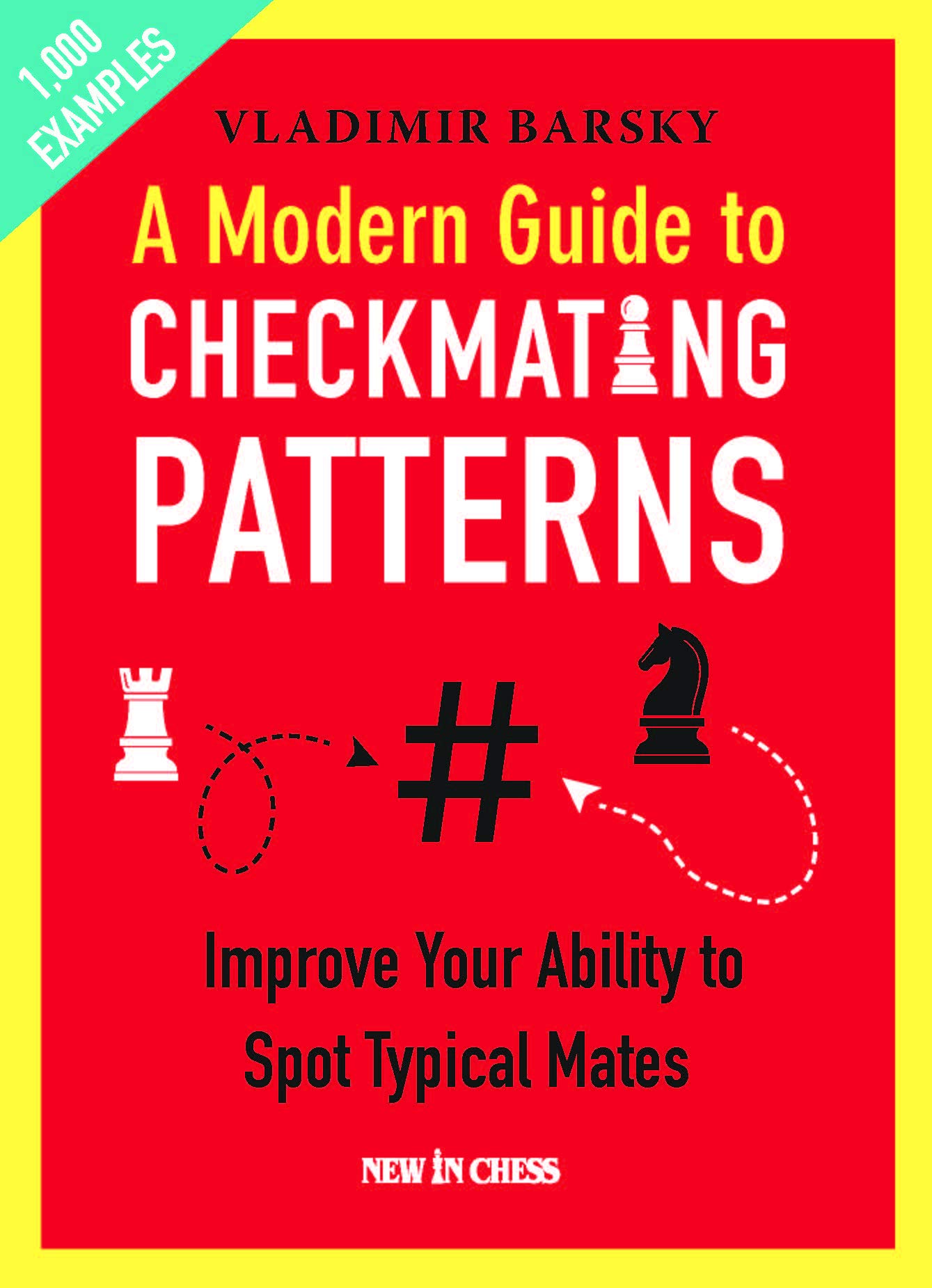A Modern Guide to Checkmating Patterns : Vladimir Barsky

From the book’s rear cover :
“Giving mate is the ultimate goal of every chess player. Finding that all-decisive combination is immensely satisfying. But how are you supposed to spot a checkmate when you are sitting at the board with the clock ticking?
In this guide International Master Vladimir Barsky teaches the method created by his mentor Viktor Khenkin (1923-2010). It’s based on an ingenious classification of the most frequently occurring mating schemes. A wide range of chess players will find it an extremely useful tool to recognize mating patterns and calculate the often narrow path to the kill.
All the 1,000 examples (850 of them in exercise format) that Barsky presents are from games played in 21st century. He has carefully selected the most instructive combinations and lucidly explains the typical techniques to corner your opponent’s king. More often than you would expect, positions that look innocent at first sight, turn out to contain a mating pattern. This is not just another book full of chess puzzles.
It’s a brilliantly organized course that has proven to be effective. Finding mate isn’t rocket science, but you need to know what to look for. Vladimir Barsky teaches you exactly that.”

“Vladimir Barsky (1969) is an International Master, an experienced chess coach and a well-known journalist and author. He lives in Moscow.”
I’ve been thinking a lot recently about the difference between instructing novices and experts.
You might find this chart (source) helpful. It’s from an education blog but there’s some chess there as well!
Let’s assume that a novice has a rating below 1000 and an expert has a rating of 2000 or over. There’s also a rather large area in between the two, which would include most competitive players, for whom you’d use a combination of the two approaches.

A novice, then, learns best through explicit instruction and worked examples. Just as you probably learnt maths at school. You learn something specific, hold your teacher’s hand while she demonstrates how to do it, then go away and try it out for yourself. You will then receive feedback on how well you have done and transfer your new found knowledge and skills from short-term to long-term memory.
Learning skills such as playing a new opening or winning a rook ending with an extra pawn, will require personalised feedback, but tactics can be taught through books or apps: you solve a puzzle on a specific theme and find out whether or not you have the correct answer.
Tactics books and, these days, apps, are rightly popular. You might, in general, think of books where each chapter concerns a specific subject to be ‘novice’ books while books with random examples where you don’t know what you’re going to get next (just as in a game) to be ‘expert’ books. But within each of these categories there are easier and harder books. Players rated between 1000 and 2000 will probably benefit most from a mixture of harder ‘novice’ books and easier ‘expert’ books.
A basic knowledge of checkmate patterns is essential for every serious player, and all chess libraries should contain at least one book on the subject. Even though most games at higher levels end in resignation, and, at lower levels, in very simple checkmates, a knowledge of these patterns plays a part in every kingside attack. You might not force mate, but your opponent may have to give up material to avoid it.
Let’s see what the author has to say in his foreword.
“The remarkable trainer and Soviet Master of Sport, Viktor Lvovich Khenkin (1923-2010), proposed systematizing mating schemes or ‘pictures’ by reference to the piece or pawn which brought the mate to its conclusion. It turned out that there were not so many of these schemes – about a hundred basic ones – and about 20 or 30 which occur in the great majority of mating combinations. These can be remembered even by an inexperienced player: ‘it’s not rocket science’, as the popular saying runs.
Khenkin was a mentor and colleague of the author and a number of other celebrated chess writers and journalists.
Barsky continues:
“This book A Modern Guide to Checkmating Patterns is divided into ten chapters: first, we present schemes and examples with explanations, and then positions for independent solving. These number 851.”
Excellent pedagogic principles. We have a total of 1000 positions, all taken from 21st century games, most of which will probably be new to you, so you won’t see the same tired old examples repeated by many authors. The chapters, in turn, feature, the rook, the queen, the minor pieces and pawns, two rooks, rook and bishop, rook and knight, queen and bishop, queen and knight, queen and rook, and, finally, three pieces. In each chapter you work through some examples with the author holding your hand before being let loose to solve some puzzles on your own. As you know what you’re looking for, most of these will not be too difficult for experienced players. Most of the positions are not forced mates, but positions in which mate threats will lead to material gain.
Here, from the game Barsky – Logunov (Moscow 2004) in Chapter 1, is the author himself in action:
White’s position looks critical since the bishop cannot retreat because of mate on d1, whilst exchanging on f4 leads to the loss of the c4-pawn. But there is an unexpected tactical blow…
37. R5xb6! a5
Mate results from 37… axb6 38. Ra8+.
38. Rb4+!
Black’s misfortunes continue – again he cannot take the rook because of 39. Ra8+.
38… Ka3 39. Rb3+
He could also win with 39. R4b5+ Ka4 40. Ra8 with mate in a few moves.
39… Ka4 40. Rxf3 Rxd6 41. Rxf4 1-0
My next example is from Chapter 7 (queen and bishop mates). It’s Black’s move in Kamsky – Svidler (Khanty-Mansiysk 2011).
White has an extra rook but it is Black to play. He could take either of the two attacked white pieces, but in that case, White gets a valuable tempo to beat off the attack, e.g. 26… Rxb8 27. Be3 or 26… Qxh6 27. Nc6,and the knight cannot be driven away, because the square e6 is attacked by the white bishop.
26… Re2!!
A very beautiful idea by the St Petersburg GM. Now after 27. Qxe2 Qg3 mate is inevitable. But why not the immediate 26… Qg3? In this case the knight retreat (27. Nc6) allows the key diagonal to be blocked.
27. Qc3 Rxf2 28. Nc6 Rxf1+
White resigned (29. Kxf1 Qf2#)
Finally, a beautiful finish from West London Chess Club’s Mark Lyell (Lyell – Bradac Zdar nad Sazavou 2010)
With three successive sacrifices, White underlines the vulnerability of the enemy king, trapped in the centre:
17. Rxe5! dxe5 18. Bxa5! Qxa5
Otherwise he is mated on d8.
19. Qa4!!
The final blow. Black resigned: after any reasonable reply, he is mated by 20. Nc7.
All serious chess players should have at least one book concerning checkmating patterns in their library. This book is an excellent example of the genre. The author knows exactly what he’s doing and why he’s doing it: something that can’t be said for the majority of instructional chess books. Furthermore, most of the examples will be unfamiliar to most readers.
My impression was that the puzzles were, by and large, easier than the worked examples: perhaps this was deliberate.
This is ‘novice’ rather than ‘expert’ tuition in that it trains specific skills and provides hints to help you solve the puzzles, but at the same time it’s not a book for beginners: there’s an assumption that you are already reasonably proficient at calculating and spotting checkmates. If you’re rated anywhere between about 1250 and 2000 and want to improve your attacking skills you’ll find this book invaluable. In addition, it provides useful coaching materials for anyone teaching students at this level. Stronger players might also want to use it as a refresher course.
You can also, if you choose, just sit back and enjoy 1000 21st century examples of brilliant and beautiful sacrificial chess.
Highly recommended, then, for all chess players who enjoy attacking the enemy king.
Richard James, Twickenham 25th February 2021

Book Details :
- Paperback : 256 pages
- Publisher: New in Chess (7th August, 2020)
- Language: English
- ISBN-10:9056918877
- ISBN-13:978-9056918873
- Product Dimensions: 17.5 x 1.68 x 23.55 cm
Official web site of New in Chess

